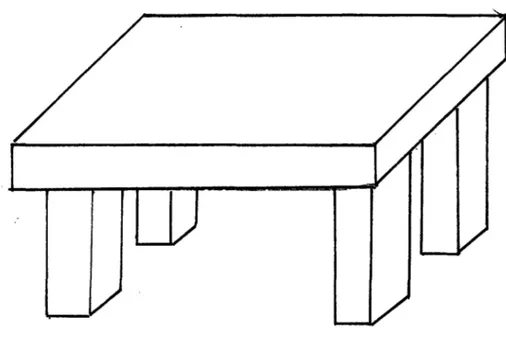MASSACH USETTS INSTITUTE OF 'I'TECHNOLOGY ARTIFICIAL INTELLIGENCE LABORATORY
A.I. Working Palp"k 241 Jan, 1983
Dynamics of Manipulators with Less Than One Degree of Freedom
D. Hillis
ABSTRACT. We have developed an efficient Lagrangian formulation of manipulators with small numbers of degrees of freedom. The efficiency derives from the lack of velocities, accelerations, and generalized forces. The number of additions and multiplications remains constant, independent of the number of joints, as long as the number of joints remains less than one. While this is a restricted class of manipulators, we believe that it is important to understand it fully before studying of more complex systems. Manipulators with less that one degree of freedom are by far the most common manipulators used by industry. We have also noticed that many of the multiple-degree-of-freedom manipulators in our laboratory tend to be used in a zero-degree-of-freedom mode. With this formulation of the dynamics it should be possible in principle to compute the Lagrangian dynamics of manipulators with less than one degree of freedom in real time.
Acknowledgments. This report describes research done at the Artificial Intelligence Laboratory of the Massachusetts Institute of Technology. My thanks to Marvin Minsky, Phil Agre, and David Chapman for pointing out relevant trends in current robotics research. A.I. Laboratory Working Papers are produced for internal circulation, and may contain information that is, for example, too preliminary or too detailed for formal publication. It is not intended that they should be considered papers to which reference can be made in the literature.
Introduction
The problem of computing the joint torques required to produce given joint positions, velocities, and accelerations, for a manipulator can be greatly simplified by eliminating all joints. Until recently the solutions to these equations required the use of more general programs which required seconds or even minutes of computer time for each trajectory point. They could not be computed in real time.
Two different types of schemes were proposed to render the Lagrangian dynamics computationally feasible: (1) simplifying the dynamics by ignoring some terms and correcting errors with feedback, and (2) simplifying the manipulator by removing degrees of freedom. We have chosen the second since it allows the inclusion of the fun-to-compute Coriolis and centrifugal forces.
The Uicker/Kahn Lagrangian Formulation
The standard formulation for manipulator dynamics may be found in Uicker [1], who represents Lagrangian based dynamics using four by four matrices. The formulations we use taken directly from Hollerbach [2], who uses the notation of Kahn [3]. Kahn numbers the links of a manipulator from 1 to
n starting from the base to the tip, with the reference frame numbered as link 0. Since we are concerned
only with manipulators with no joints the zero link is of utmost importance. The coordinate system is fixed in each link as follows:
zi is along the axis of joint i + 1,
zi is along the common normal from zi. to z1, and /i goes off in some completely different direction.
The symbols s8i, ai, Oi, and ai are of no concern to us since they represent relative position of two adjacent links. Since this would make the equations go away entirely, we shall complicate the situation by modeling our single-link manipulator as a two-link system with a fixed connecting joint. In other words, 00 =0.
Dynamics without Motion
Figure 1. Standard coordinate axes of a manipulator with no degrees of freedom
fixed in link j expressed in link i coordinates. Then adjacent coordinate systems are related by the relation:
i-lvi = - ivj (1)
where Ai is the 4x4 transformation matrix between coordinate systems i - 1 and i:
1 0 0 0
ai cos Bi cos 0 - sin Oi cos ai sin 0O sin ac
ai sin Oi sin O cos 0, cos as - cos 0G sin a(2)
a. 0 sin c~ cos a
J(
We define Ao = I, the identity matrix. Any two coordinate systems i and j can be related by cascading the transformations:
iv = i"W vk (3)
Dynamics without Motion
superscript when referring to the base coordinate system, so that vk = ov and Wy = oWi.
Using this notation, the generalized forces Fi can be derived from the Lagrange equations [1,2,3]:
=i
(aw
+ kW=T a2 wT=1where
Jj is the inertia tensor with respect to the proximal joint of link j expressed in j's body coordinates,
mi is the mass of link j,
9 is the gravity vector, and
ir is the coordinate of the center of mass of link j expressed in link j's body coordinates. To make the paper look more impressive we include here some addition equations:
n+1 n-k n + 1 n - k(-)n-k-iZi
k=Do i=o
(xn)n-lirn -ii E(IXi - E(Xi)Ik) =0
lim
= 0
n--o (F!L'1E(IX, - E(X,)12)) -for k > 2
Some researchers ]1 have considered this too slow for real time computation. But notice that, in (4), if for all i all 0i = 0 and ai = 0, then all of the matrices A = 0 will be identity matrices. Thus, Fo = m0 ao. Given the proper initial conditions, it is possible to make the manipulator stand still by applying no force. This is fortunate since there is no way to apply force anyway. We believe that this computation is simple
Figure 2. Industrial use of four zero-degree-of-freedom manipulators to support table top.
References
[1] J. J. Uicker, "On the Dynamic Analysis of Spatial Linkages Using 4x4 Matrices," Ph. D. Thesis, Northwestern University, August 1965.
[2] J. M. Hollerbach, "A Recursive Lagrangian Formulation of Manipulator Dynamics," MIT Artificial Intelligence Laboratory Memo AIM-533, June 1979.
[3] M. E. Kahn, "The Near-Minimum-Time Control of Open-Loop Articulated Kinematic Chains," Stanford Artificial Intelligence Project Memo AIM-106, December 1969.

